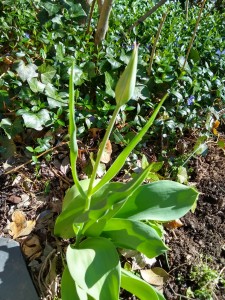 At this time of year I am always envious of my neighbor’s fabulous daffodil array, which covers her entire front yard and sidewalk strip with a golden blanket of spring color. My own front yard has also awakened from its gray slumber, with hellebores still in bloom, more daffodils every day, a few remaining squills and hyacinths perfuming the air with their glorious scent.
At this time of year I am always envious of my neighbor’s fabulous daffodil array, which covers her entire front yard and sidewalk strip with a golden blanket of spring color. My own front yard has also awakened from its gray slumber, with hellebores still in bloom, more daffodils every day, a few remaining squills and hyacinths perfuming the air with their glorious scent.
Only one thing is missing—tulips.
Tulips are missing because my efforts to grow them have been consistently thwarted by varmints. In the fall, squirrels dig up the newly planted bulbs. If I am lucky they replant them elsewhere, but more often than not, the bulbs just disappear. Those that squirrels overlook sleep through the winter and sprout hopefully in the spring, only to be nipped off by deer. Despite chemical and physical precautions designed to deter these four-footed plant predators, the tulip assassination has gone on unabated for so long that I finally decided to stop buying them.
Now I look around me and see tulips coming up everywhere. The public gardens are full of them. Median strips and gas station islands feature lavish displays. Pops of vibrant color are beginning to appear in borders throughout my neighborhood. Clearly the squirrels and deer are so sated when they get through with my property that they ignore all the others. The whole scene drives me mad with jealousy.
To add insult to varmint-inflicted injury, the early bulb catalogs have arrived, advertising fantastic savings on fall planted bulbs, including scores of luscious tulips. I see so many objects of desire: seductive ‘Apricot Beauty’; pale yellow, double-flowered ‘Verona’; dark-petaled ‘Paul Scherer’; and the gorgeous white fringes of ‘Honeymoon’ to name a few. My mouth waters, my
wallet tingles and I vow to find some way to have as many tulips as possible. 
Of course, like everything else that is truly worthwhile, restoring tulips to my garden is going to take planning and work. My eye roves to “The Seven Habits of Highly Effective People”, which, like all semi-effective people, I have pinned up above my desk. Number two reads, “Begin with the End in Mind.”
The end I have in mind is a tulip-filled garden next year. Now I start the effort.
Bulb vendors have several recommendations for ensuring tulip survival, including spraying bulbs with animal repellent and letting the bulbs dry off before planting. Squirrels and underground plant terrorists like voles may be deterred by surrounding the bulbs in their planting holes with crushed gravel. Covering freshly planted areas with hardware cloth may also keep off squirrels. Once the bulbs sprout, deer-afflicted gardeners should keep the repellent handy, spraying plant tips when they appear and repeating regularly throughout the season, especially after rain.
I may take those suggestions, but I may also simply make use of available resources, namely the large number of containers in my garage. If I take advantage of pre-season prices and order lots of tulips now, they will arrive at proper planting time. I can pot them up and let them reside in the unheated garage for the winter, far from hungry varmints. Next spring, I will either put those pots on my porch or spread them around the garden, taking pains to apply the deer spray regularly.
Some gardeners might say, “Why take all that trouble for such unreliable plants?” After all, most commercially-available tulips, with the exception of species types, are inconsistent the second year and frequently absent thereafter.
Growing limited numbers in-ground and larger numbers in pots will allow me to deal with that issue by digging up the bulbs after they bloom and storing them in a cool, dry place until fall. This treatment does not ensure rebloom, but makes it more likely. Second year tulips are rarely as flashy as their first-year siblings, but if they are lifted and replanted in secondary locations, they can provide dots of color in the landscape.
Growing next year’s tulip crop in pots will not only add immeasurably to my garden, it will allay my guilt about keeping all those empty pots around. It also helps with my enduring desire to live up to “The Seven Habits of Highly Effective People.” A“win-win”, like the one I plan to have with tulips, is number four on the list.
